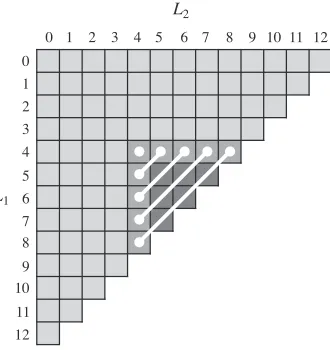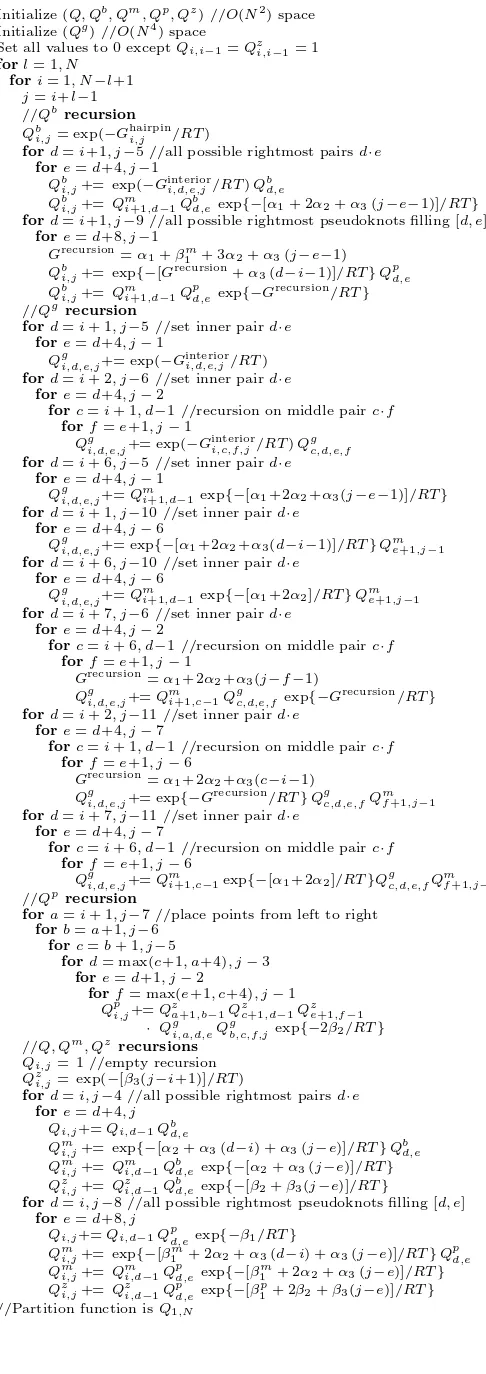Supplementary Material:
A Partition Function Algorithm for Nucleic Acid
Secondary Structure Including Pseudoknots
ROBERT M. DIRKS1, NILES A. PIERCE2
1
Department of Chemistry, California Institute of Technology, Pasadena, CA 91125 2
Department of Applied & Computational Mathematics and Department of Bioengineering, California Institute of Technology, Pasadena, CA 91125
Received 16 December 2002; Accepted 5 March 2003; J Comput Chem 24: 1664–1677, 2003
α
2
α2 α
3
α
3
α3 α3
α3
α
3
α1 α2
α
1
α
3
α
3 α3α3
α
2
α2
α
3
α
3
α
2
Figure S1. Multiloop energy expression. For this example there are three base pairs defining the multiloop (B= 3) and six unpaired bases in the multiloop (U = 6) soGmulti=α
functionfastiloops(i, j, l, Qb, Qx, Qx2)
//QxrecursionforO(N3) internal loop contributions toQb if(l≥15) //smallest subsequence not added toQbas special case
L1= 4 //explicitly add in terms forL1= 4,L2≥4 //Next convertQxinto interior loop energies fors= 8, l−7
if(sequence permitsi·jbase pair) Qb
i,j+=Qxi,sexp{−γ3(i, j, i+1, j−1)/RT}
//Extend loops fromstos+2 for future calculation //ofQb
//Add small inextensible interior loop terms toQbas special cases forL1= 0,3
//Add bulge loops and large asymmetric loops as special cases
forL1= 0,3 //CasesL1= 0,1,2,3,L2≥4
Figure S2. Pseudocode for computing interior loop con-tributions to Qb in O(N3) as an alternative to the
O(N4)
interior loop recursion of Figure 8. Here, N is the length of the strand andl=j−i+1 is the length of the substrand under consideration at any given point during the recursive process. A schematic representation of “fastiloops” is pro-vided in Supplementary Material Figure S3. The smallest “possible extensible loop” is the caseL1=L2= 4 with size
s= 8. Therefore, the smallest subsequence for which Qx
can be employed isl= 15 (adding the four bases fori, d, e, j
and a minimum hairpin of three bases between d·e). For a giveni and j, Qx
i,s already contains the contributions to
Qb
i,jfor all extensible loops of sizesexcept for the two cases
when eitherL1= 4 orL2= 4 (which cannot be obtained by
extending smaller loops that use a different energy expres-sion). EnrichingQxi,swith these two new possible extensible
loops, we then convertQxi,sinto contributions toQ b i,j by
in-troducing the term for closing these loops with pairi·j. Qxi,s
is then extended to provide future values ofQxi−1,s+2. All other interior loop contributions (cases with either L1 ≤3
or L2 ≤ 3) are then added directly to Qbi,j using the
spe-cial energy expressions of the standard model implied by
Ginternal
i,d,e,j . Note that the subsequence lengthlis fixed inside
each call to the function “fastiloops”. Hence, specifying i
implies j = i+l−1. For subsequences of length l, we use
Qx
i,s(j implied) to computeQxi−1,s+2 (j+1 implied) which will later be used to compute contributions toQb
i−1,j+1for subsequences of lengthl+2. Thus, for a given value ofl, the values ofQx
i,sneed only be stored for all legal values ofiand
suntillhas been incremented 3 times, at which point it can be discarded. This is accomplished by usingQx1
i,s and Q x2
i,s
0 1 2 3 4 5 6 7 8 9 10 11 12 L2
L1
0
1
2
3
4
5
6
7 8
9 10
11
12
Figure S3. Schematic for interpreting the pseudocode of Supplementary Material Figure S2, which computes the interior loop contributions to the partition function inO(N3
). For a giveni(withjimplied by the current subsequence lengthl), the grid illustrates the method of computing contributions to Qb
i,j for all interior loops with sides of lengthL1 andL2. For the
depicted case, the maximum interior loop size iss=L1+L2= 12. Adding seven bases to account for the closing basesi, d, e, j
and the smallest allowed hairpin of three bases betweend·e, the subsequence under consideration is therefore of lengthl= 19. TheO(N) pale gray cases with eitherL1 ≤3 orL2 ≤3 use special energy functions and are added explicitly toQbi,j. The
medium gray and dark gray cases are the possible extensible loop contributions that are computed usingQxi,s. Each diagonal
line spans the terms that will be stored in Qxi,s for a particular value of s. The medium gray terms are the new possible
extensible loops with eitherL1 = 4 orL2= 4. The dark gray terms were previously incorporated into toQxi,s by extending
β3
Figure S4. Illustration of the pseudoknot energy expression. a) An external pseudoknot. Bases external to the pseudoknot have no associated energy. The penalty for forming an external pseudoknot is β1 . Base pairs that border the pseudoknot
interior receive penaltyβ2 while unpaired bases on the pseudoknot interior receive penaltyβ3. The energies associated with
the stacked base pairs are described using the standard model. b) A pseudoknot inside a multiloop. The penalty for forming a pseudoknot inside a multiloop isβm
1 . The treatment ofβ2 andβ3 inside the pseudoknot remains the same. In addition, the
standard penalty for formation of a multiloop isα1, the two pseudoknot base pairs that border the multiloop are given the
standard multiloop penaltyα2, and unpaired bases that are inside the multiloop are given penaltyα3. c) A pseudoknot within
a pseudoknot. The energy treatment for the exterior pseudoknot remains the same. The penalty for forming a pseudoknot inside a pseudoknot is β1p. Base pairs from the interior pseudoknot that border the exterior pseudoknot receive penalty
β2. Otherwise, the energetic treatment of the interior pseudoknot is the same as for an exterior pseudoknot. The partition
Initialize (Q, Qb, Qm, Qp, Qz) //O(N2) space Qi,j= 1 //empty recursion Qz
Figure S5. Pseudocode implementation of anO(N8)
a)
b)
Figure S6. Examples of pseudoknots that are excluded from the partition function recursions. Neither structure can be decomposed into two spanning regions as required by Figure 15. The structure prediction recursions of Rivas and Eddy25
functionfastiloops(i, j, l, Qg, Qx, Qx2)
//QxrecursionforO(N5) internal loop contributions toQg if(l≥17) //smallest subsequence not added toQgas special case
ford=i+6, j−10
//ConvertQxinto interior loop energies if(l≥17 & sequence permitsi·jbase pair)
//Extend loops for future use
if(i6= 1 &j6=N)
//Add small inextensible interior loops toQgas special cases forL1= 0,min(3, d−i−2)
//Add bulge loops and large asymmetric loops as special cases
forL1= 0,min(3, d−i−2) //CasesL1= 0,1,2,3,L2≥4
Figure S7. Pseudocode for computing interior loop con-tributions to Qg inO(N5) as an alternative to the
O(N6)
interior loop recursion of Figure 19. Here, N is the length of the strand andl=j−i+1 is the length of the substrand under consideration at any given point during the recursive process. The smallest “possible extensible loop” is the case
L1=L2= 4 with size s= 8. Therefore, the smallest
subse-quence for whichQx can be employed isl= 17 (adding the
four closing basesi, c, f, j, the additional spanning paird·e, and a minimum hairpin loop of three bases). For given val-ues ofi,dande,Qx
i,d,e,s already contains the contributions
toQgi,d,e,jfor all extensible loops of sizesexcept for the two cases when either L1= 4 or L2= 4 (which cannot be
ob-tained by extending smaller loops that use a different energy expression). EnrichingQx
i,d,e,s with these two new possible
extensible loops, we then convertQxi,d,e,s into contributions
to Qgi,d,e,j by introducing the term for closing these loops with pair i·j. Qxi,d,e,s is then extended to provide future
values ofQxi−1,d,e,s+2. All other interior loop contributions (cases with eitherL1≤3 orL2≤3) are then added directly
toQbi,j using the special energy expressions of the standard
model implied byGinternali,d,e,j . Note that the subsequence length
lis fixed inside each call to the function “fastiloops”. Hence, specifyingiimpliesj=i+l−1. For subsequences of length
l, we useQx
i,d,e,s (j implied) to compute Qxi−1,d,e,s+2 (j+1 implied) which will later be used to compute contributions toQgi
−1,d,e,j+1for subsequences of lengthl+2. Thus, for a given value ofl, the values of Qx
i,d,e,s need only be stored
for all legal values of i, d, e, and s until l has been incre-mented 3 times, at which point it can be discarded. This is accomplished by usingQx1
i,d,e,s andQ x2
i,d,e,s to store future






